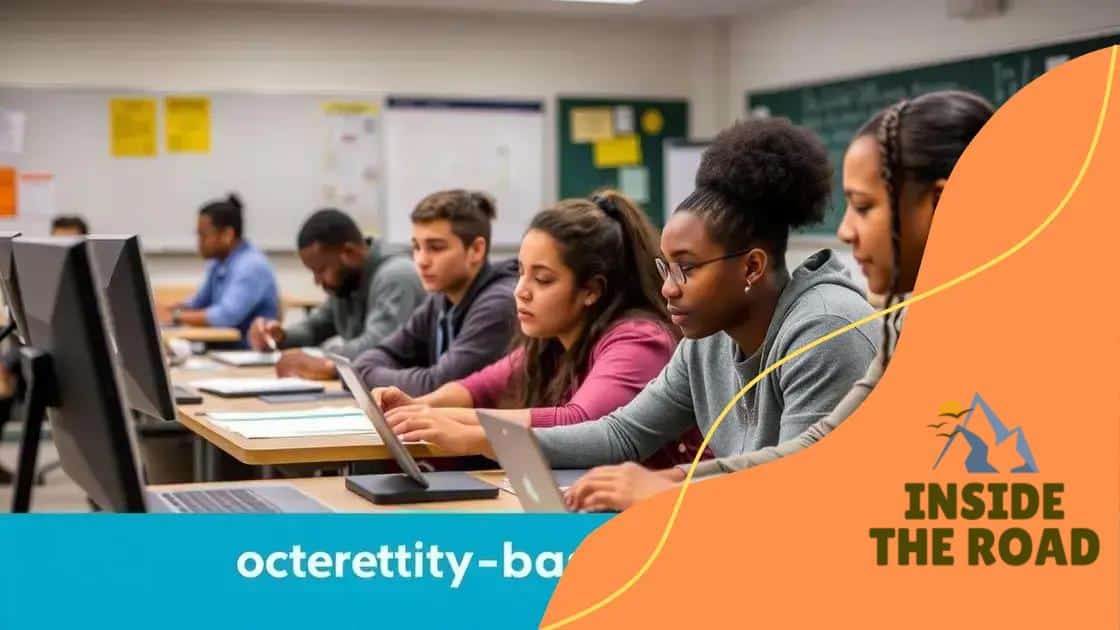The shift toward competency-based education models

The shift toward competency-based education models emphasizes personalized learning, allowing students to master skills at their own pace, thereby increasing engagement and preparing them for real-world challenges.
The shift toward competency-based education models is changing how we think about learning. Have you ever wondered how personalized education could transform your experience? Let’s explore this topic together.
Understanding competency-based education
Understanding competency-based education is essential for grasping its impact on learning. This approach allows students to learn at their own pace, emphasizing skills rather than time spent in class. By focusing on each student’s strengths and weaknesses, education becomes more personalized and effective.
What is competency-based education? This model reshapes traditional learning environments by providing a more tailored experience. Rather than progressing through a set curriculum, students advance upon mastering specific competencies. This allows for deeper understanding and retention of knowledge.
Key components of competency-based education
- Personalized learning pathways
- Assessment based on skills and abilities
- Flexible pace and progression
Additionally, competency-based education incorporates ongoing assessments. These assessments ensure that students possess the necessary skills before moving on. This focus on mastery not only helps students gain confidence but also prepares them for real-world challenges.
Moreover, instructors play a crucial role in this model. They serve as guides, helping students navigate their learning journeys. This mentorship fosters stronger connections and supports a more engaging learning atmosphere.
Benefits for students
There are several benefits to adopting a competency-based framework. Students experience:
- Increased engagement in their learning
- Greater ownership of their education
- More time for complex problem-solving
With these advantages, it becomes clear why understanding competency-based education is vital for educators and learners alike. By recognizing its value, we can pave the way for enriched academic experiences that meet diverse needs.
Key benefits of competency-based models
Key benefits of competency-based models highlight why many educational institutions are shifting toward this innovative approach. By focusing on individual students’ mastery of skills, these models create more effective learning environments.
One significant advantage is that students can progress at their own pace. This flexibility allows them to spend more time on challenging subjects while quickly advancing through areas where they excel. As a result, students experience a greater sense of achievement.
Enhanced learning experience
Competency-based education fosters a deeper understanding of material. It encourages students to engage with the content actively. Rather than memorizing facts, students develop practical skills they can use in real-life situations.
- Students receive immediate feedback on their performance.
- They can revisit areas needing improvement without feeling rushed.
- This dynamic approach can lead to increased motivation and interest in learning.
Moreover, competency-based models cater to different learning styles and preferences. By offering various pathways to demonstrate mastery, educators can meet the diverse needs of their students. This approach not only supports academic growth but also promotes personal development.
Real-world relevance
Another important benefit is the connection to real-world applications. Competency-based education prepares students for the job market by focusing on essential skills employers seek. This relevance helps students see the value in their education and increases their employability.
Furthermore, students build confidence as they acquire competencies that matter in the workplace. Instead of simply passing exams, they can showcase their skills to potential employers. This hands-on learning aspect makes education more meaningful.
Challenges in implementing competency-based education

Challenges in implementing competency-based education are important to consider for schools transitioning to this innovative approach. While the benefits are clear, several hurdles must be navigated to achieve success.
One major challenge is the need for teacher training and professional development. Educators must fully understand the competency-based model to effectively implement it in their classrooms. This transition requires significant changes in teaching styles and assessment methods.
Institutional resistance
Alongside this, there can be institutional resistance to change. Some schools may hesitate to move away from traditional grading systems. This reluctance can stem from fears about accountability or concerns over how competency-based education will affect student outcomes.
- Changing evaluation methods can cause confusion.
- Parents may be unfamiliar with these new systems.
- Colleges might not recognize competency-based credits.
Additionally, the implementation of competency-based education can be resource-intensive. Schools may require new technology and materials to support personalized learning environments. This often means budget adjustments and potential funding challenges.
Technology integration concerns
Another significant aspect is the integration of technology. Effective competency-based education often relies on digital platforms for monitoring student progress and providing resources. However, not all educators are comfortable with using technology, which can hinder the implementation process.
Furthermore, disparities in access can pose a challenge. Students in low-income areas may lack the necessary tools and internet access to fully engage with a competency-based system, making equity an pressing issue.
These challenges can seem daunting, but addressing them is crucial for the successful adoption of competency-based education. Understanding the obstacles helps schools prepare for a smoother transition into this modern educational approach.
Case studies of successful schools
Case studies of successful schools provide valuable insights into the effective implementation of competency-based education. By examining these examples, we can learn about best practices and strategies that lead to positive outcomes.
One notable case is the Harrison School District in Colorado. This district transformed its approach to education by adopting a competency-based model. They focused on student mastery, allowing learners to progress at their own pace. As a result, student engagement significantly increased, and graduation rates improved.
Innovative practices in action
Another successful example is the Summit Public Schools in California. Summit emphasizes personalized learning plans, where each student sets goals based on their abilities. Teachers act as facilitators, guiding students through their learning journeys. By tailoring instruction to individual needs, students feel more empowered and accountable for their education.
- Flexible pacing allows students to master skills without feeling rushed.
- Regular check-ins ensure students stay on track and receive support when needed.
- This model fosters a strong school community where collaboration thrives.
The Kansas City Missouri School District also stands out. They implemented a blended learning model, combining technology and face-to-face instruction. This approach allows for customized educational experiences, accommodating varied learning styles. Students benefit from interactive platforms that provide immediate feedback, enhancing their learning.
Positive outcomes
These case studies demonstrate the potential of competency-based education to transform learning environments. Schools that embrace these models often see improvements in student motivation, achievement, and overall satisfaction. As more schools follow suit, the positive ripple effects will impact the education landscape.
Future trends in education technology
Future trends in education technology are shaping the landscape of learning in exciting ways. As technology continues to advance, educators must adapt to new tools that enhance the teaching experience.
One significant trend is the rise of artificial intelligence in education. AI can personalize learning by analyzing student data and adapting lessons to fit their unique needs. This technology allows for a more tailored approach, ensuring every student progresses at their own pace.
The growth of adaptive learning
Another important trend is adaptive learning technology. This approach uses algorithms to modify educational content based on student performance. As students engage with materials, the system identifies areas where they struggle and provides additional resources to help them succeed. This not only boosts understanding but also fosters independence in learning.
- Students receive instant feedback on their performance.
- Lessons can be adjusted on-the-fly to better suit the learner.
- This approach can increase engagement and motivation.
Additionally, the integration of virtual and augmented reality is becoming more prevalent in education. These technologies allow students to immerse themselves in different environments or scenarios, enhancing their learning experiences. For example, students can explore ancient civilizations or conduct science experiments in a safe, virtual space.
Collaboration through technology
One more trend is the emphasis on collaborative tools. With the rise of online learning platforms, students can work together on projects from anywhere in the world. This not only builds teamwork skills but also exposes students to diverse perspectives.
Overall, as we look at the future of education technology, it’s clear that these innovations will create more engaging and effective learning environments. By embracing these trends, educators can better meet the needs of their students and prepare them for success in a rapidly changing world.
FAQ – Frequently Asked Questions About Competency-Based Education
What is competency-based education?
Competency-based education focuses on student mastery of skills, allowing learners to progress at their own pace rather than through a set timeline.
What are the key benefits of this educational approach?
Key benefits include personalized learning, greater student engagement, mastery of real-world skills, and improved outcomes through technology integration.
What challenges do schools face in implementing competency-based models?
Common challenges include the need for teacher training, resistance to change from traditional methods, resource allocation, and technology integration.
How does technology enhance competency-based education?
Technology, such as AI and adaptive learning platforms, enables personalized learning experiences and provides immediate feedback to students.






